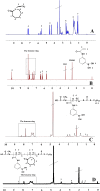Glucose-Sensitive Nanoparticles Based On Poly(3-Acrylamidophenylboronic Acid-Block-N-Vinylcaprolactam) For Insulin Delivery
- PMID: 31632018
- PMCID: PMC6781948
- DOI: 10.2147/IJN.S220936
Glucose-Sensitive Nanoparticles Based On Poly(3-Acrylamidophenylboronic Acid-Block-N-Vinylcaprolactam) For Insulin Delivery
Abstract
Background: Compared with random copolymers, block copolymerization is easier to prepare for nanoparticles with core-shell structure, and they will have better glucose sensitivity and higher insulin loading.
Purpose: In our study, insulin-loaded poly (3-acrylamidophenylboronic acid-block-N-vinyl caprolactam) p(AAPBA-b-NVCL) nanoparticles were successfully prepared and were glucose-sensitive, which could effectively lower the blood sugar levels within 72 hrs.
Methods: The polymer of p(AAPBA-b-NVCL) was produced by reversible addition-fragmentation chain transfer polymerization based on different ratios of 3-acrylamidophenylboronic acid (AAPBA) and N-vinylcaprolactam (NVCL), and its structure was discussed by Fourier transform infrared spectroscopy and 1H-nuclear magnetic resonance . Next, the polymer was manufactured into the nanoparticles, and the characteristics of nanoparticles were detected by dynamic light scattering, lower critical solution temperature, and transmission electron microscopy. After that, the cell and animal toxicity of nanoparticles were also investigated.
Results: The results demonstrated that p(AAPBA-b-NVCL) was successfully synthesized, and can be easily self-assembled to form nanoparticles. The new nanoparticles included monodisperse submicron particles, with the size of the nanoparticle ranged between 150 and 300nm and are glucose- and temperature-sensitive. Meanwhile, insulin can be easily loaded by p(AAPBA-b-NVCL) nanoparticles and an effective sustained release of insulin was observed when the nanoparticles were placed in physiological saline. Besides, MTT assay revealed that cell viability was more than 80%, and mice demonstrated no negative impact on blood biochemistry and heart, liver, spleen, lung, and kidney after intraperitoneal injection of 10 mg/kg/d of nanoparticles. This suggested that the nanoparticles were low-toxic to both cells and animals. Moreover, they could lower the blood sugar level within 72h.
Conclusion: Our research suggested that these p(AAPBA-b-NVCL) nanoparticles might have the potential to be applied in a delivery system for insulin or other hypoglycemic proteins.
Keywords: 3-acrylamidophenylboronic acid; AAPBA; N-vinylcaprolactam; NVCL; glucose-sensitive; nanoparticles; temperature-sensitive.
© 2019 Wu et al.
Conflict of interest statement
The authors report no conflicts of interest in this work.
Figures











Similar articles
-
Synthesis and evaluation of temperature- and glucose-sensitive nanoparticles based on phenylboronic acid and N-vinylcaprolactam for insulin delivery.Mater Sci Eng C Mater Biol Appl. 2016 Dec 1;69:1026-35. doi: 10.1016/j.msec.2016.07.078. Epub 2016 Aug 2. Mater Sci Eng C Mater Biol Appl. 2016. PMID: 27612799
-
Phenylboronic acid-diol crosslinked 6-O-vinylazeloyl-d-galactose nanocarriers for insulin delivery.Mater Sci Eng C Mater Biol Appl. 2017 Jul 1;76:845-855. doi: 10.1016/j.msec.2017.03.139. Epub 2017 Mar 18. Mater Sci Eng C Mater Biol Appl. 2017. PMID: 28482599
-
Glucose- and temperature-sensitive nanoparticles for insulin delivery.Int J Nanomedicine. 2017 May 29;12:4037-4057. doi: 10.2147/IJN.S132984. eCollection 2017. Int J Nanomedicine. 2017. PMID: 28603417 Free PMC article.
-
Poly(N-vinylcaprolactam): a thermoresponsive macromolecule with promising future in biomedical field.Adv Healthc Mater. 2014 Dec;3(12):1941-68. doi: 10.1002/adhm.201400371. Epub 2014 Oct 29. Adv Healthc Mater. 2014. PMID: 25354338 Review.
-
Bioresponsive Functional Phenylboronic Acid-Based Delivery System as an Emerging Platform for Diabetic Therapy.Int J Nanomedicine. 2021 Jan 12;16:297-314. doi: 10.2147/IJN.S284357. eCollection 2021. Int J Nanomedicine. 2021. PMID: 33488074 Free PMC article. Review.
Cited by
-
Synthesis of multi-responsive poly(NIPA-co-DMAEMA)-PBA hydrogel nanoparticles in aqueous solution for application as glucose-sensitive insulin-releasing nanoparticles.J Diabetes Metab Disord. 2024 Mar 27;23(1):1259-1270. doi: 10.1007/s40200-024-01421-7. eCollection 2024 Jun. J Diabetes Metab Disord. 2024. PMID: 38932860 Free PMC article.
-
Structure-Based Varieties of Polymeric Nanocarriers and Influences of Their Physicochemical Properties on Drug Delivery Profiles.Adv Sci (Weinh). 2022 Apr;9(10):e2105373. doi: 10.1002/advs.202105373. Epub 2022 Feb 3. Adv Sci (Weinh). 2022. PMID: 35112798 Free PMC article. Review.
-
Novel glucose-responsive nanoparticles based on p-hydroxyphenethyl anisate and 3-acrylamidophenylboronic acid reduce blood glucose and ameliorate diabetic nephropathy.Mater Today Bio. 2021 Dec 3;13:100181. doi: 10.1016/j.mtbio.2021.100181. eCollection 2022 Jan. Mater Today Bio. 2021. PMID: 34927045 Free PMC article.
-
Nanoparticles prepared from pterostilbene reduce blood glucose and improve diabetes complications.J Nanobiotechnology. 2021 Jun 27;19(1):191. doi: 10.1186/s12951-021-00928-y. J Nanobiotechnology. 2021. PMID: 34176494 Free PMC article.
-
Recent Advances in the Drugs and Glucose-Responsive Drug Delivery Systems for the Treatment of Diabetes: A Systematic Review.Pharmaceutics. 2024 Oct 20;16(10):1343. doi: 10.3390/pharmaceutics16101343. Pharmaceutics. 2024. PMID: 39458671 Free PMC article. Review.
References
MeSH terms
Substances
LinkOut - more resources
Full Text Sources
Medical

